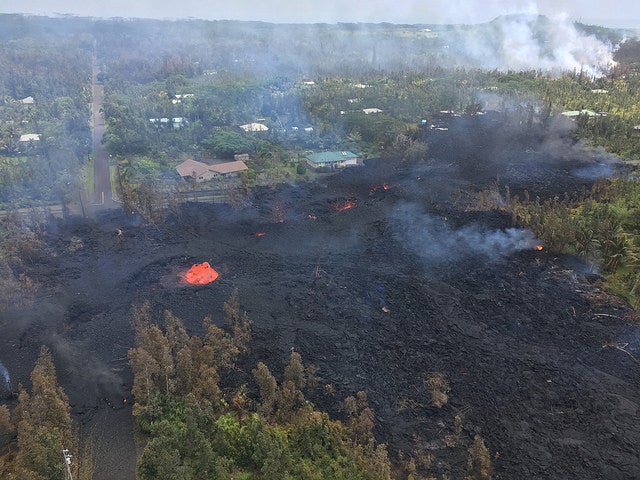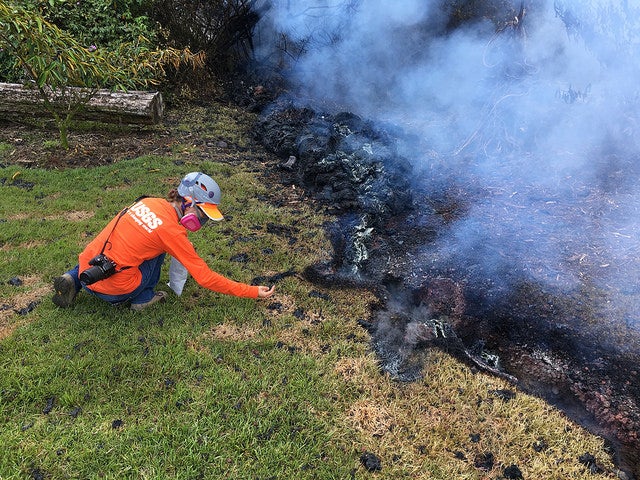This article was published in Scientific American’s former blog network and reflects the views of the author, not necessarily those of Scientific American
Things remain pretty heated in Hawaii. The Leilani Estates eruption continues apace, at least thirty-five homes have been destroyed, and there's no sign the lava will stop any time soon. What comes next, no one knows for sure; but judging from the ongoing seismic activity in the area, and the continued opening of new fissures, it looks like the eruption certainly won't be ending this week.
So, what's been going on since Friday?
Hawaii experienced its biggest earthquake since 1975, and aftershocks are continuing. Chris Rowan has an excellent post up about it, explaining what happened:
On supporting science journalism
If you're enjoying this article, consider supporting our award-winning journalism by subscribing. By purchasing a subscription you are helping to ensure the future of impactful stories about the discoveries and ideas shaping our world today.
The focal mechanism of the earthquake—the largest earthquake recorded on Hawaii since a magnitude 7.4 in 1975—indicates compression on a fault about 5 km below the surface. It is probably related the fact that the whole flank of Kilauea is sliding towards the sea. As the volcano is built upwards by eruptive activity, it spreads outwards along a weak detachment at the contact between the strong oceanic crust that the Big Island is built on top of, and the weaker jumble of fractured lavas and other volcanic debris that it is built from.
One thing's for sure: there'll be a lot more shaking going on.

"Fissure 7 began this morning [May 5th] around dawn and was active for several hours. At the peak of its activity, large bubble bursts occurred at one spot (lower left) in the fissure while spattering was present in other portions. A short lava flow was erupted from the fissure around 8 a.m. HST, moving northeast and crossing Hookupu St." Credit: U.S. Geological Survey
Since the eruption began, a total of twelve fissure vents have opened, all within the Leilani Estates subdivision. They've emitted not just lava spatter, but prodigious amounts of sulfur dioxide gas, which is extremely dangerous. It can burn your skin and ruin your lungs. The area around the eruption site is extremely dangerous. If you are a resident or in the area, please heed all warnings and evacuation orders.
For the first few days, most of the vents were erupting for only a few hours at a time before going quiet, and the lava flows were only traveling a few tens of yards, piling up about two yards high, before coming to a stop. And the fountain heights were modest, typically only reaching up to about one hundred feet.
Things got a lot more showy on Saturday, May 5th, though! The fissure eruption from the vent on Luana Road produced fountains that soared 330 feet into the air.
The following day, an a'a flow fed by Fissure 8 spent the morning traveling, managing to make it over half a mile from its source before the fissure stopped feeding it.
Meanwhile, up on Kilauea's summit, the lava lake has lowered by over 722 feet. It spend all of Sunday draining by around 6.5 feet per hour. That lava isn't ending up at the Pu'u Ō'ō area, which as of this writing has no active magma. Both the summit and Pu'u Ō'ō crater continue to deflate as magma drains. We know that lava is migrating down the East Rift Zone; and although things quieted down lava-fountain wise in Leilani Estates by Monday night, it's almost certain this is merely a pause. The ground is still cracking. This eruption ain't over yet!
You can follow the USGS Volcanoes Facebook page, the USGS HVO Observatory alerts and updates, and the Hawaii County Civil Defense Agency website for updates on the eruption. Hawaii News Now has been an excellent resource for local news. I also recommend following the Twitter feeds of Dr. Janine Krippner and Erik Klemetti for news, photos, videos, and more.
I'm doing a deep dive into Kilauea geology and will have more about this vigorous volcano soon. Stay tuned and stay safe!

Thank you, USGS geologists! " As part of their monitoring work, HVO geologists collect samples of spatter for laboratory analysis; information gained from these samples sheds light on what's happening inside Kīlauea Volcano. This photo, taken at 10:35 a.m. today [May 6th], shows fissure 10 near the intersection of Malama and Pomaikai Streets in Leilani Estates." Credit: U.S. Geological Survey